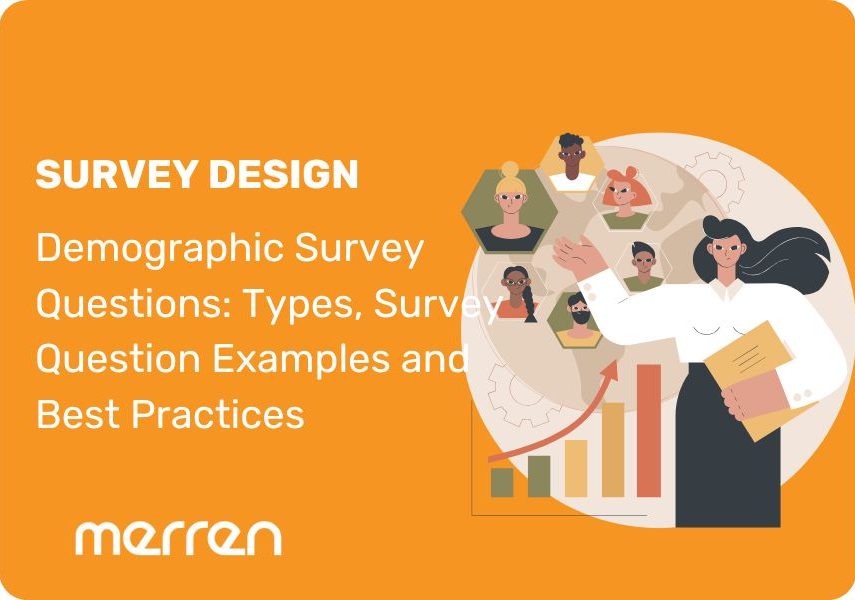Demographic survey questions collect personal information from a group of people in a population. The questions are based on their age, income levels, ethnicity, family background, educational level and more. In market research, basic demographic questions provide critical information about your target audience.
In this blog, we will discuss the importance of demographic questions in a survey and their types. We will also mention popular survey question examples and best practices to write demographic questionnaires.
What are the Types Of Demographic Questions In Surveys?
Here are the types of questions to ask in a demographic survey:
- Age
- Gender
- Ethnicity
- Geography
- Location
- Household income levels
- Educational qualifications
- Occupation and Industry
- Marital status
- Religion preferences
- Family and dependents
- Home ownership
- Ownership of motorized vehicles
- Political affiliations
Why Do You Need Demographic Survey Questions for Research?
Collecting personal information may seem intrusive, but demographic survey questions give you a clarity on your target audience. Here is why researchers, companies and governmental organisations depend on demographic questionnaires:
1. To collect census data
Governmental organisations conduct a census every decade (also known as decennial census) to segment population into various groups: age, ethnicity, income group and other detailed metrics. It collects demographic, economic and social data to modify policies and structures for the particular country.
2. To create customer-buyer persona
A customer-buyer persona is a fictional character that humanizes your target market. Demographic questions are a source to understand a customer’s requirements, purchasing capacity, purchasing motivations and current need-gaps. Based on this, organisations at various levels will modify their offerings and marketing communications.
Example: McDonalds had to curate their menu before launching in the Indian subcontinent. This was done to regard the local cultural eating habits and beliefs.
3. To segment people across markets
Market segmentation helps businesses focus on their specific target market without confusing messaging. Segmentation includes buyers who are millennial vs Gen Z, new mothers vis-a-vis single professionals etc.
An organisation might offer demographic survey questionnaires to understand the expenditure levels and patterns. Their aim is to understand spending patterns of millennials from tier 1 cities vs millennials from a tier 2 city. The data could be vastly different. Depending on the data, companies may upsell/ cross-sell premium products for millennials from tier 1 cities. Whereas, companies may offer better deals and membership discounts for millennials from tier 2 cities.
4. To remain inclusive among sensitive target markets
Well-balanced demographic survey questions will make sure that the data is not manipulated to suit just one specific audience. This is relevant especially when sensitive questions around political beliefs, gender or religious preferences are involved. Organisations can collect detailed information on diverse populations to curate personalized experiences.
5. To stay relevant and relatable to your target audience
Demographic survey questions collect information from people across geographical boundaries. To customise their messaging, companies share marketing information in multiple languages, context and via different channels. This is a critical step when a company is spread across geographical regions.
Example: A giant ecommerce platform customises their offerings based on their location. Amazon creates a diverse catalog of products on their websites for the USA and India. This customisation positively impacts Amazon’s high Net Promoter Scores.
14 Types of Demographic Survey Question with Examples
Each type of demographic survey question has a purpose in market research. Here are the 14 most popular examples:
1. Age
Age-based demographic question is the most popularly used survey question across companies. This is done in industries such as media and entertainment, social media account creation, alcohol and beverage, automobile and banking & insurance sectors.
Question 1: Which category best describes your age range?
- Under 18
- 18-24
- 25-34
- 35-44
- 45-54
- 55 and above
Question 2: What is your date or birth?
Here the respondent can choose a date from the drop down calendar in a survey form. This approach is specific.
2. Gender
Gender-based survey questions are popular to understand how marketers can adjust messaging to push specific products or to collect categorical data. It is used in FMCG industries, media and entertainment, social media platforms and certain governmental policies curated for the specific gender.
Question: What is your gender?
- Male
- Female
- Non-binary/Third gender
- Prefer not to say
3. Ethnicity
Ethnicity demographic questions help companies remain inclusive and accommodating to the particular ethnicity. This demographic question is used to tailor marketing communications without offending the sense and sensibilities of people belonging to the particular ethnicity. A respondent may choose one or more ethnicity.
Question: Which race/ethnicity best describes you? (Select all that apply)
- African American
- Asian
- Caucasian
- Hispanic or Latino
- Native American
- Other
4. Geography
Geographical demographic data will reveal the origin of your target market. This information can be used to improve logistical services in ecommerce industries. This is relevant for companies located in those countries. This data will also reveal population density in various regions for census data.
Question: Where do you currently live?
- India
- Indonesia
- Japan
- Indonesia
- South Korea
- Others (please specify)
5. Location
While location demographic questions are similar to geography, location focuses on a very specific area (sometimes with pin code details). This information is used for market segmentation, geo-targeted advertising, and logistics. It is heavily used in eCommerce, retail, travel, real estate, and public services.
Question: What is your ZIP/postal code?
This open-ended question accepts answers in numerical format only.
6. Household income levels
Income-based demographic data helps segment users by purchasing power. It’s particularly useful in luxury goods, financial services and insurance, real estate, and automotive industries.
Question: What is your total annual household income before taxes?
- Less than $20,000
- $20,000 – $39,999
- $40,000 – $59,999
- $60,000 – $79,999
- $80,000 – $99,999
- $100,000 or more
7. Educational qualifications
Educational qualification is an important demographic question that will understand the knowledge level and content preferences of your audience. It’s commonly used in EdTech, corporate training, recruitment, and political polling.
Question: What is the highest level of education you have completed?
- Less than high school
- High school diploma or equivalent
- Associate degree
- Bachelor’s degree
- Master’s degree
- Doctorate or higher
8. Occupation and industry
Occupation and industry demographic questions help customize services or communication relevant to their profession. This is vital for B2B companies, professional service providers, and insurance firms.
Question 1: Which industry do you work in?
- Healthcare
- Education
- Technology
- Finance
- Retail
- Manufacturing
- Other (please specify): _______
9. Marital status
Marital status demographic question enables brands to understand lifestyle choices and household dynamics. This influences buying behavior in industries like insurance, real estate, healthcare, and family-oriented services.
Question: What is your marital status?
- Unmarried
- Married
- In a domestic partnership
- Divorced
- Widowed
- Prefer not to say
10. Religion preferences
Religion-related demographics are sensitive but helpful to fathom cultural practices and preferences. This is true for international or localized marketing campaigns.
Question: What is your religious affiliation?
- Christianity
- Hinduism
- Islam
- Buddhism
- Judaism
- Other
- No religion
11. Family and dependents
Understanding family composition can guide product recommendations, content strategies, and support services. This is especially important for FMCG, healthcare, and financial planning.
Question: How many dependents (children or adults) do you support?
- None
- 1
- 2
- 3 or more
12. Home ownership
Questions based on home ownership are popular while collecting census data. It denotes the condition of the current economic and social status. Home ownership questions also guide real estate, insurance, and home improvement industries. They can segment users based on living situations and potential needs.
Question: Do you own or rent your home?
- Own
- Rent
- Living with parents/relatives
- Other (please specify)
13. Ownership of motorized vehicles
Vehicle ownership indicates socioeconomic status and lifestyle. This data is valuable to automotive companies, insurance firms, and marketers targeting commuter segments.
Question 1: How many vehicles do you currently own?
- None
- 1
- 2
- 3 or more
Follow-up question 2: What type of vehicle do you own?
- Car
- Motorcycle/Scooter
- Truck/Van
- Electric Vehicle
- None
14. Political affiliations
Questions on political affiliations are often used in polling, media targeting, or cause-based campaigns. These fall under sensitive questions. Keep questions must be kept objective and should be asked with care.
Question: Which political party do you most identify with?
- Conservative
- Liberal
- Independent
- Other (please specify)
- Prefer not to say

Best Practices for Demographic Survey Questions
Demographic questions in a survey need to be detail oriented and objective in tone and language. Since it seeks personal responses from people, the main aim is to solicit responses from respondents. Here are the best practices to note.
1. Ask only relevant questions
Tie every demographic question to a research objective. Don’t include demographic questions just for the sake of it. Only seek information you truly need to achieve your research goals.
For example, if your survey is about online shopping habits, asking about vehicle ownership might be irrelevant.
2. Be respectful and inclusive
Avoid making assumptions about gender, ethnicity, religion, or sexual orientation. Offer inclusive response options and include “Prefer not to say” to respect privacy.
Example: Instead of asking: “Choose your gender: Male or Female”
Ask: “What is your gender?”
- Male
- Female
- Non-binary / Third gender
- Prefer to self-describe: _______
- Prefer not to say
3. Use a jargon-free neutral language
Cultural references or double-baralled questions can deter respondents. Keep the language simple, direct, and easy to understand for all audience segments. We recommend testing your questions with a small audience to ensure clarity and neutrality.
4. Provide mutually exclusive and exhaustive options
Provide every answer choice clearly and represent all possible options. Example: for income brackets, avoid overlapping numbers.
- $20,000 – $39,999
- $40,000 – $59,999
(Not $30,000 – $50,000 and $50,000 – $70,000)
5. Offer open-ended survey questions
Certain demographic questions may not include every option (for questions based on geography, location and industry). Offer open ended questions where people can explain the reason for their selection or provide a single word answer.
6. Keep options anonymous and private
Open the demographic survey questionnaire with a note as follows: Your responses will remain confidential and will be used for statistical purposes only. This assures respondents of their privacy and they will be open to sharing their responses with genuine interest. Demographic questions on religion, political affiliation and sexual orientation will be sensitive in nature. Assure people of anonymity and privacy upfront.
What to Do After Collecting Demographic Survey Responses?
Don’t let data overwhelm you. These pointers will guide demographic data collection
Validate and clean survey data
Remove incomplete or duplicate survey entries. Check for inconsistent responses (e.g., contradictory age and education data).
Avoid asking new demographic questions
Every market research should have a clear goal. Keep a goal of asking 2 to 3 demographic questions that will help you understand your target audience. Probing people on fresh demographic questions can raise eyebrows.
Segregates responses based on response filters
Merren groups responses based on demographic survey filters such as location, age, income etc. Segmenting your audience by location might show that urban customers prefer digital communication, while rural customers respond better to phone support. You can filter out responses from people who do not meet your criteria of research.
Do not ask the same questions again
Demographic data is personal in nature. People may not be willing to answer the same questions from the same organisation. Use CRM systems to register demographic survey responses and curate marketing strategies based on the pre-existing data. Merren can help you store and access crucial demographic data with losing any access or breaching any privacy metrics.
Analyze correlations and refine strategies
Trends in demographic data can reveal groups that are more price sensitive, have purchasing power or the average age group of your customers. Use this information to tailor email campaigns, ads, or product recommendations based on demographic segments.
How to Increase Response Rates in Demographic Survey Questions?
Demographic questions can feel personal, so it’s essential to approach them with care and clarity. Here are ways to increase response rates:
1. Mention the reason for the demographic question
include a short note like: “We ask a few demographic questions to better serve your needs. Your answers remain anonymous.” This encourages response rate and reduces drop off at the start of the survey.
2. Design survey for faster input
Create short surveys that take less cognitive effort from people. Create drop-down menus or choose number ranges with a click. For questions that ask date of birth, scrolling over a calendar can be a hassle. Provide an open-ended space for people to type the date of birth.
3. Use progressive profiling when necessary
Collecting demographic data in one go can overwhelm respondents. If you have user details collected in your system, share demographic questions in a survey gradually over time.
4. Offer survey incentives to increase participation
The value of survey incentive should align with the length and sensitivity of the survey.
Consider small post-response incentives like discounts, vouchers, or entry into a giveaway. However, not every demographic questions require a post-response incentive. Certain demographic questions are necessary for the entertainment industry and SaaS industry.
Example: During onboarding, users have to answer demographic questions on the sign up page. The questions pertain to their age, employment levels, size of the company and personal details such as email address and name.

Best Survey Channels to Run Demographic Survey Questions
Choosing the right survey channel impacts both the quality and quantity of responses. Here are the top-performing channels for demographic questionnaires:
1. Email surveys
Email surveys are perfect for customers who have already subscribed to your newsletters. Email surveys are best for longer or segmented surveys where you’re collecting detailed demographic information. Use personalization and clear CTAs to boost click-through and response rates. Merren uses AMP technology so that you can send surveys without sending respondents into an external link.
2. WhatsApp surveys
WhatsApp surveys have the highest open rate of 98%. Demographic questions are short and need a one-click response. WhatsApp surveys are ideal to seek responses in a conversational format. Works great in markets with high WhatsApp usage like India, LATAM, Southeast Asia.
3. Social media polls
Social media polls are useful for top-of-funnel audience understanding. Limited in depth but useful for collecting single data points (e.g., age range or location).
4. Website chatbots
AI-driven chatbots have a capacity to collect complex and detailed information from customers. This makes chatbot an ideal survey channel to collect demographic information from customers. Its conversational and interactive format encourages a high response rate.
Use Merren to Create Demographic Questions in A Survey
Sign up using Merren CX, an AI-driven market research platform.
- Write the organisation details and access all tools on the new dashboard. Click on +create a survey and get started.
- Choose from various language translations to create multilingual demographic surveys. Create your own questions and include skip logic to avoid drop-off rate.
- Demo test surveys across channels and edit errors before publishing.
- Choose from various survey channels and collect demographic responses on the CX dashboard.
- View all results via graphs, charts and apply filers relevant to your research.
Conclusion
Create demographic questions in a survey using the best practices. Merren is an AI-driven market research platform that helps marketers and customer experience leaders collect critical insights from users, customers and target audiences. Stay ahead with data-driven insights. Sign up for a 14 day free trial and learn about market trends with responsive surveys.

